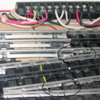colored wire
hokie71, wires can be hidden with weeds, bushes, trash, or yard ballast.
You may want to Back Up and reconsider your wiring. For Non-Derailing, your individual control wires are soldered to the inside V rails and your outside rails are jumpered together for common. Your inside V rails should have no continuity with each other or any other track. Drill holes in track to make soldering easier.

For clarity this photo shows all wiring on top side, the control wires are shown inside black circles. The bottom of the track Vs have hot glue inserted to keep control tracks electrically separated. Insulate the control tracks from the running tracks with track pins.
Soldering info that may be helpful is toward the bottom of this page, Toy Train Layout Wiring - Soldering.
Ross instructions (yours is probably similar to the RossReady):
Regular Switch Manual
RossReady
DZ1000 Switch Machine













